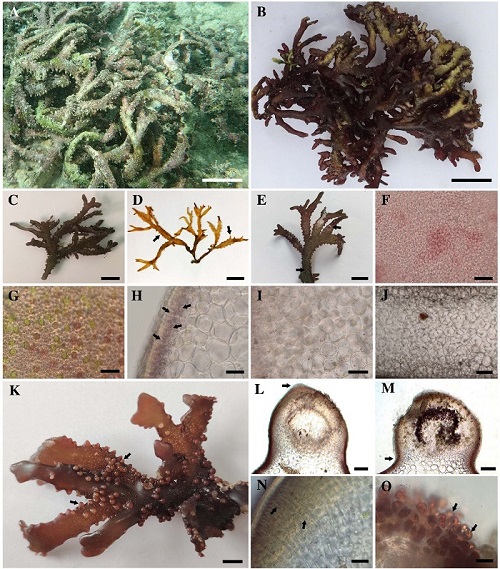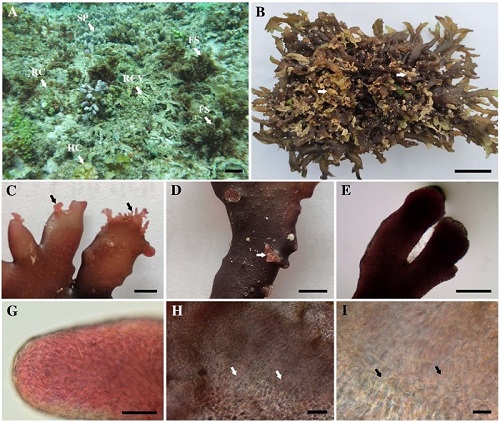Economic and Scientific Values of Hydropuntia eucheumatoides
Hydropuntia eucheumatoides belongs to the genus Hydropuntia, family Gracilariaceae, order Gracilariales, phylum Rhodophyta. This red seaweed species holds high economic value and is considered a beneficial food source for human health due to its rich calcium and iodine content, along with its cooling properties, making it particularly suitable for consumption during hot seasons. It is widely utilized as a leafy vegetable, in jelly and beverage production, as an ingredient in various desserts, and serves as a raw material for agar extraction, among other applications. However, due to its economic importance, the species has been heavily and continuously exploited, leading to a significant decline in its natural population and biomass.
Hydropuntia eucheumatoides is classified as a rare and valuable marine alga and was included in the Vietnam Red Data Book (2007) under the endangered category: EN A1a, c, d—indicating a high risk of extinction. Proposed conservation measures include the establishment of strictly protected areas and regulated harvesting in other regions. Nevertheless, most of its natural distribution areas remain unprotected (except within certain marine protected zones), and there are currently no effective conservation or sustainable management measures in place. As a result, the species is being overharvested and faces a serious risk of extinction. Therefore, studying its biological and ecological characteristics and distribution patterns is essential for supporting resource recovery and the future development of seaweed aquaculture for this species.
Morphological Characteristics of the Red Seaweed Hydropuntia eucheumatoides
Scientists from the Research Institute for Marine Fisheries conducted two field surveys in April and June 2023 to investigate the biological and ecological characteristics of Hydropuntia eucheumatoides distributed in the Ly Son Marine Protected Area, Quang Ngai Province. A total of more than 20 specimens of H. eucheumatoides were collected for morphological examination.
The results indicated that H. eucheumatoides grows prostrate, reaching up to 10 cm in height and spreading 30–40 cm in width, with a reddish-brown to dark purple coloration (Fig. 1A). The thallus is foliose, cartilaginous, and irregularly branched, either pinnately or dichotomously, sometimes appearing in series (Fig. 1B). Branches are flat and thick, without cylindrical branches, typically 1–4 cm long, 5–10 mm wide, and 2–7 mm thick (Fig. 1C). Margins of the branches bear serrations or blunt lobes about 1–1.5 mm in length; short spiny protrusions occasionally develop on the surface (Fig. 1D, E).
Both dorsal and ventral surfaces of the branches are covered with 1–2 layers of small epidermal cells, round in shape, with diameters of 3–5 µm (Fig. 1F, G). Transverse sections of branches show a cortex consisting of 3–4 cell layers. The outermost cells are longitudinally elongated (10–25 µm in length), while the inner cortical cells are round, 5–10 µm in diameter (Fig. 1H). The medulla comprises 10–15 layers of round to oval cells, ranging from 35 µm to 300 µm in diameter, with cell size increasing from the cortex toward the center (Fig. 1I). In longitudinal sections, medullary cells are arranged in alternating rows, relatively uniform in shape (Fig. 1J).
Tetrasporangia are elongated or clavate in shape, measuring approximately 50 × 15 µm, non-cruciately divided, and surrounded by elongated cortical cells. Spermatangial sori are irregularly shaped, branched, usually deeper than wide, measuring around 130 × 40 µm, and composed of 3–6 smaller sori. Cystocarps are prominent on the branch surface, spherical in shape, measuring 1–1.5 × 1.5–2 mm (Fig. 1K). Their apex is slightly pointed with a narrowed base (Fig. 1L, M). The pericarp is 400–500 µm thick, consisting of 25–30 layers of cells. The outer cell layers are vertically elongated (20–25 × 10–13 µm), while the inner layers are round, aligned in rows, with retracted protoplasts that do not connect (Fig. 1N). Carpospores are spherical, measuring 15–20 µm in diameter (Fig. 1O).
 |
Figure 1. Morphology of Hydropuntia eucheumatoides
(A) Natural growth form, prostrate growth; (B) Thallus blade-like, irregular branching; (C) Flattened, thick branch; (D) Dry specimen, branch margins with serrations or papillate projections (arrow); (E) Short spiny proliferations on the dorsal surface of the branch (arrow); (F) Epidermal cells (dorsal surface of the branch); (G) Epidermal cells (ventral surface of the branch); (H) Transverse section of the branch, outer cortical cells elongated (arrow), inner cortical cells rounded (arrow); (I) Transverse section of the branch, medullary cells; (J) Longitudinal section of the branch, rows of uniform medullary cells; (K) Cystocarps protruding from the branch surface (arrow); (L, M) Longitudinal section of cystocarps, apex slightly rostrate (arrow), base slightly constricted (arrow); (N) Detailed structure of cystocarp pericarp, outer cells cylindrical (arrow), inner cells rounded (arrow); (O) Spherical carpospores (arrow).
Scale bars: (A, B) 5 cm; (C, E) 2 cm; (D) 3 cm; (F, G, H) 20 µm; (I) 50 µm; (J, L, M) 200 µm; (K) 1 cm; (N, O) 20 µm.
Assessment of Habitat Conditions and Substrate Composition for Hydropuntia eucheumatoides
Two field surveys conducted in April and June 2023 at the Ly Son Marine Protected Area revealed that seawater temperature is one of the most critical environmental factors influencing the distribution of Hydropuntia eucheumatoides. Low temperatures slow down the growth of the seaweed, while excessively high temperatures can cause fragmentation, degradation, and mortality. This species thrives in warm waters with an average temperature of 29.6 ± 0.63°C, which explains its distribution being limited to central and southern coastal waters of Vietnam and its absence in the northern region, where winter temperatures drop significantly.
In addition to temperature, the habitat of H. eucheumatoides is characterized by high salinity (33.1 ± 0.18‰), slightly alkaline pH (8.10 ± 0.03), high dissolved oxygen concentration (6.48 ± 0.10 mg/l), low turbidity (0.40 ± 0.05 FTU), shallow depth (2.1 ± 0.31 m), and clear water with visible bottom. Nutrient concentrations remain within the permissible limits established in QCVN 10:2023/BTNMT for coastal marine waters, indicating good water quality in the species’ habitat.
Regarding substrate characteristics, H. eucheumatoides is primarily found on consolidated coral rock substrates formed from dead, interlocked coral reefs. This substrate type accounts for 89.2 ± 6.2% of the seabed composition and supports four main benthic components: H. eucheumatoides (5.0 ± 3.3%), other macroalgae excluding H. eucheumatoides (12.6 ± 5.0%), live hard corals (5.0 ± 1.4%), and sponges (4.3 ± 1.5%). The remaining 62.3 ± 7.4% of the substrate is bare consolidated coral rock without significant benthic cover. Interspersed among the rocky substrate are sandy areas comprising coral sand (mostly fine to medium grains) and coarse coral gravel (a mixture of sand and fragmented coral branches), accounting for 10.8 ± 6.2%.
H. eucheumatoides exhibits a creeping growth form and attaches to the substrate via disc-shaped holdfasts located beneath the prostrate branches. The high proportion of rough, consolidated coral rock (89.2 ± 6.2%) provides an ideal substrate for secure attachment and growth, supporting the species’ establishment and development within the Ly Son Marine Protected Area.
 |
Figure 2. Distribution and Morphology of Holdfasts in Hydropuntia eucheumatoides
(A) Natural growth form, algae growing prostrate and attaching to the substrate; (B) Ventral surface of thallus with holdfasts firmly attached to the substrate (arrow); (C) Holdfasts developing at the tips of branches (arrow); (D) Holdfasts developing on the ventral surface of prostrate branches (arrow); (E) Holdfast structure; (G) Tip of the holdfast; (H) Surface cells of the holdfast arranged in rows radiating from the center, including elongated cylindrical cells and rounded cells (arrow); (I) Detailed structure of surface cells of the holdfast (arrow).
Scale bars: (A, B) 5 cm; (C, D) 5 mm; (E) 1 mm; (G, H) 100 µm; (I) 50 µm.
Scientific Basis for the Restoration of Hydropuntia eucheumatoides in the Ly Son Marine Protected Area
In the Ly Son Marine Protected Area, Hydropuntia eucheumatoides typically grows in patches, spreading prostrately and attaching firmly within crevices and on dead coral reef rocks. It is found from the lower intertidal zone to the upper subtidal zone at depths of 3–4 meters, in areas characterized by clear water and moderate to strong wave action. The species initiates its growth cycle in December and January, exhibits optimal development between March and June, and shows limited growth during the rainy and stormy season (August to October). Vegetative regeneration is the primary mode of reproduction.
This species adheres to hard substrates via disc-shaped holdfasts that develop on the underside of creeping branches upon contact with the benthic surface. These holdfasts form strong attachments to the substrate, making it difficult for wave action to dislodge them—although fronds may break, the holdfasts remain anchored. H. eucheumatoides only thrives on hard substrates, which provide a stable surface that prevents dislodgement by waves or tidal currents. In contrast, if it grows on sandy, gravelly, or broken coral substrates, it is easily swept away by hydrodynamic forces, impeding its establishment and growth. When thalli are removed, the holdfasts often remain attached to substrate particles, including sand, gravel, and coral fragments.
This ecological understanding provides a crucial scientific foundation for researchers at the Research Institute for Marine Fisheries to design effective restoration strategies. Specifically, it supports the use of fixed-attachment cultivation techniques on natural and artificial hard substrates as a viable method for restoring H. eucheumatoides populations in the wild.
Do Anh Duy, Bui Minh Tuan